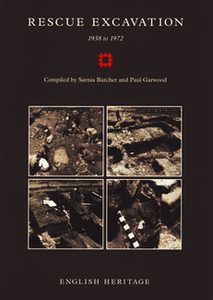English Heritage Archaeological Monographs
English Heritage, 2014. https://doi.org/10.5284/1028203. How to cite using this DOI
Data copyright © English Heritage unless otherwise stated
This work is licensed under the ADS Terms of Use and Access.
Primary contact
Historic England
The Engine House
Firefly Avenue
Swindon
SN2 2EH
Resource identifiers
- ADS Collection: 1416
- DOI:https://doi.org/10.5284/1028203
- How to cite using this DOI
Rescue Excavation 1938 to 1972
Garwood, P., Butcher, S.
English Heritage (1994)
Abstract:

Government sponsorship of rescue archaeology became a recognised policy before the 1939-45 war, and grew massively in scale over the succeeding decades in response to the huge growth in construction and redevelopment which was affecting both urban and rural areas. In the early 1970s, when it became clear that effort and funding needed to be concentrated on the post-excavation and publication requirements of the work, a programme was instituted to bring to completion those projects which had received government funding over the previous decades and to ensure that the information resulting from the work was publicly available. This report charts the achievements of that programme. It covers projects which received government funding between 1938 and 1972, the date when regional archaeological organisations were set up to cope with the still-growing demands for rescue archaeology, and central government therefore ceased to have direct responsibility for the work. It lists, under each site, the excavators who worked on the site, the dates of the excavations, the broad archaeological periods represented, details of publications resulting from the work, and, where relevant, the number of the NAR archive deposit. It is a valuable resource, not only as a record of the large amount of work carried out with public funding since the war, but also as a mine of information about the investigations that have taken place in all areas of archaeology in England over the last half century.
Download monograph
| Rescue Excavation 1938 to 1972, Garwood, P.|Butcher, S., English Heritage (1994), ISBN: 9781848021792 | 35 Mb |





